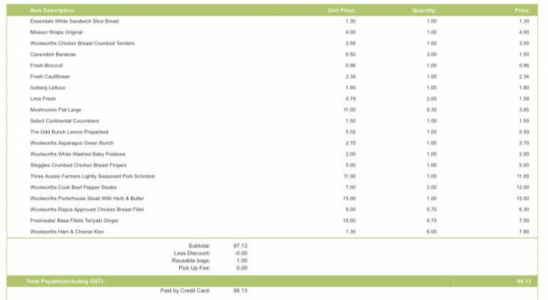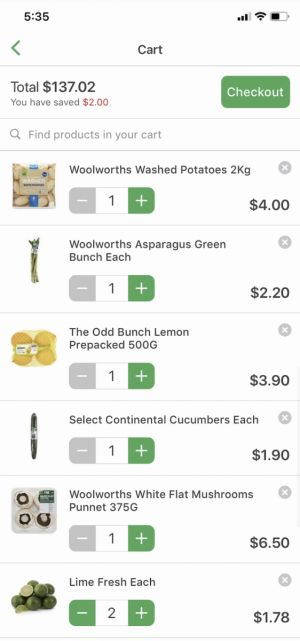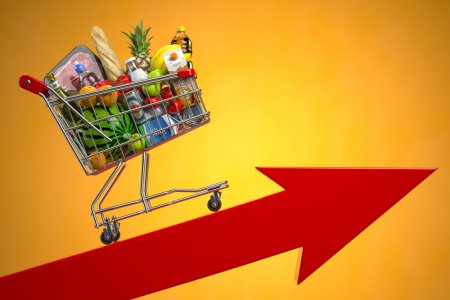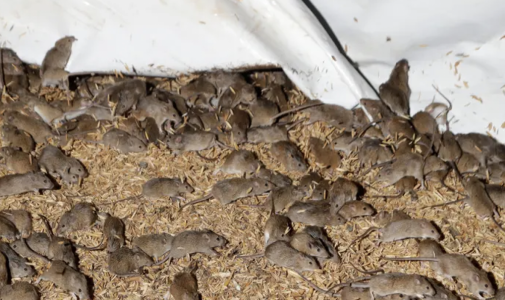Australia's Grocery Price Hike and what we plan to do about it
- Replies 31
You probably read our article yesterday on what you can expect from us in 2022, but what we didn’t touch on is that we are wanting to focus now, more than ever, on the best deals and discounts you can get on your weekly grocery shop.
Unfortunately, it’s no secret that grocery prices are going up, and if you haven’t noticed that you’re spending a bit more money on your weekly trip to the supermarket, then you may have read some of our articles last year that spoke about things like dairy product prices increasing. It seems increasing prices aren’t stopping at dairy products, in fact it’s kind of going to affect a lot of our household staples.
As we did our research on grocery prices at the end of 2021, we stumbled upon this ‘Reddit’ thread of people discussing how much their grocery bills have increased from 2020 to 2021. Basically, one Aussie was asking if anyone else had found that the cost of living was rising substantially. They stated that they knew that inflation has stayed pretty consistent at 3-4%, according to the Reserve Bank of Australia (RBA), but that it feels like everywhere you go, everything is costing a hell of a lot more than what it was just a year before. From cafes, to Bunnings and all the supermarkets, everything just seems more expensive, and they wanted to see what other Aussies thought.
When we say the Reddit thread went ‘crazy’, we mean it. There were hundreds of Aussies commenting saying they had not only noticed the cost of living was increasing substantially, but that the biggest and most hard hitting increase was their grocery bill. Take this one Aussie, a user named “AnOldMate”, for example, because he even has proof:
“Some people are claiming grocery shopping hasn’t increased and if it has, it hasn’t gone up a lot. I found an old grocery order from Woolworths from November 2020, the cost was $98." You can see this bill below (Sorry members, it's not the best quality).
“I’ve gone onto the Woolworths online shop and added the exact same items (two items not available so I got the cheaper option then what I paid last year) In December 2021, the same shop is $137." You can see this bill below.
That’s a whole $39 more for the exact same grocery shop just one year later…
I guess if you’re someone who has noticed your weekly grocery shopping hitting the wallet a little harder than usual, then you can take some solace in the fact that it’s not just you that’s noticing this. But what is it exactly that’s driving up the cost of our groceries? A previous article we posted in 2021 discussed the role of the pandemic and panic buyers in causing a sharp jump in prices. I mean we all remember the terrors of trying to get toilet paper back in 2020, but that was over 2 years ago now? And hasn’t panic buying calmed down a bit? Well, it turns out that panic buying is really only one factor in a series of factors that is leading to this bizarre grocery price increase, other factors include:
Inflation
Inflation is pretty standard. I mean, take it from the reddit user “AnOldMate” who said that inflation was only 3-4% according to the RBA (don’t worry, we double checked this and he’s right). We saw inflation fluctuate a lot between 2020 and 2021 with the pandemic, but it really hasn’t gone up any more than normal, meaning that we can’t blame these massive price hikes purely on inflation.
Low supply and high demand
Basically, we all want the same supplies, whether it be meat, vegetables, toilet paper or your favourite block of chocolate (this is the high demand), and the reality is there isn’t exactly enough to go around. Now, by this we aren’t saying there is a shortage, but we are saying that supermarkets like Coles, Woolies, Aldi and IGA are having to fight more than ever, to get their stock (this is the low supply). Which naturally drives up the prices, because the highest bidder always wins. You get the gist eh?
The reason we are seeing a low supply of common grocery goods can be put down to three major causes, they are shipping issues, natural disasters and supply chain issues. But let’s break these down a little, shall we?
Shipping issues
Now who here remembers the Ever Given ship I spoke about in our 21 events that defined 2021 article? You know the ship that somehow ended up diagonal across the canal in Egypt because of “a gust of wind” and stopped one of the biggest shipping routes in the world for about 5 days? Well, this not-so-little shipping issue probably had something to do with our grocery prices going up.
You see, this 5 day delay didn’t just stop ships from being able to get through the canal, it made them reroute to a longer route, which, when carrying perishable items isn’t exactly ideal. Now, I know what you’re thinking, surely perishable food would be frozen? And it is. But the longer it’s in that ship, the closer it gets to it’s best before date, and the later it gets onto the shelves and into our homes. Which means one of two things: either we get it just before it goes out of date or it doesn’t get to us in time and the product gets disposed of.
In addition to this ship blocking the world’s busiest shipping route, we have the pandemic. The pandemic adds even more time to the shipping process because everything has to go ‘into isolation’ (yes, just like us humans) before it can hit Australian shelves. Which makes that time on the ship even longer and of course, the longer it’s on the ship, the more it costs the importers. The more it costs the importers, the more our supermarkets have to pay to get the stock on our shelves…
So I guess that being the whole shipping thing, maybe we should just buy Australian-made products, because doesn’t that kind of solve everything?
Natural disasters
Well, I’m glad you asked. But unfortunately, buying Australian-made products doesn’t necessarily keep those grocery prices down. Why? Well, our Aussie farmers have had a pretty tough few years. From fires, to mice plagues (remember the one I spoke about in this article) to flooding and droughts, it’s been bloody hard going. We’ve seen huge crops destroyed, farm animals killed, and Aussie farmers really struggle to get their produce on the shelves. So the less product there is, the more expensive they become, because of the whole high demand, low supply the Aussie farmers that do have supply (and had to work their bottoms off to supply it), can charge more purely because one, there’s more competition trying to get their product (the highest bidder, wins again) and two, they probably had to work far harder than usual to produce their crop against all the elements.
Supply chain issues
And you know what? We really wished it stopped there, but it doesn’t. As if shipping delays and natural disasters weren’t enough, we’ve seen the entire supply chain impacted by the pandemic. Whether that be our truckies struggling to travel interstate and when they do, contracting COVID and having to isolate, leaving them unable to work for at least two weeks, to workers in the factories themselves either contracting COVID, having family members contract COVID so they have to isolate and so on and so forth. Essentially, workers become scarce, less people are on the manufacturing floor or transporting the products around the country, therefore churning out less work OR working overtime, costing the companies more to churn out the same amount of work as a normal amount of employees would.
Shrinkflation
Okay, I feel like we can’t talk about price hikes without addressing shrinkflation, so I’m going to keep this segment short and sweet. What is shrinkflation you might be thinking? According to Collins Dictionary, shrinkflation is a reduction in size of an item of packaged food, such as a chocolate bar, while the price remains the same. Basically, if you have ever thought to yourself wow, those Cadbury blocks or those packets of pasta used to be a lot bigger, but I must be ‘imagining things’. Well, you're not imagining things. The reality is a lot of the products on our shelves today used to be a lot bigger.
Here’s a great example for you: Let’s say you usually buy a 1kg bag of flour for $2. Seems reasonable, eh? Then a year later you notice that the same packet of flour is only 700g but still costs $2. If you buy the same number of items then your expenses aren't going to increase, but with smaller quantities being offered, you're going to have to go and buy more to make up for it, resulting in more money being spent and more visits to the supermarket, hitting your wallets harder than ever.
Of course with low supply and high demand, we could start to see our everyday products shrink even more so the product can be dispersed across a greater number of people. Now we aren’t saying this is what is happening or will happen, but here’s a rough example so you get the picture. Let’s say our strawberry farmers had a shocking season. Majority of the strawberry crops were ruined, leaving a small amount of strawberries available to harvest. The strawberry farmers then sell their strawberries to a supermarket chain who decides to put fewer strawberries in each punnet, but doesn’t lower the price to reflect this because they had to buy them from the farmers at an increased price…
Wow Maddie, you’re making some sense here, so where does this leave us?
Well my friends, long story short, it’s actually a bloody nightmare. Technically, if 2022 were to be better pandemic-wise than 2020 and 2021 then we should see our grocery costs coming down, but it’s really hard to say whether that will actually happen. There are two main reasons for why it’s hard to say whether 2022 will be better cost-wise:
So I guess long story short, you can expect 2022 to be a year of the unknown in terms of grocery prices, so we really want to focus on comparing our top supermarkets products (Coles, Woolies, Aldi and IGA) for pricing and quality to see what is worth you spending your money on, and what’s a total rip off.
We are also going to keep a really close eye on all of these supermarkets’ weekly deals, to make sure you can optimise your grocery shopping in the best way possible. Basically, we are taking our deals and discounts to a whole new level, to make sure these price increases don’t hit your wallet too hard.
Stick with us ladies and gents and we will take care of you in 2022.
Sources: Reddit, Trading Economics, sl.nsw.gov.au and ABC.
Unfortunately, it’s no secret that grocery prices are going up, and if you haven’t noticed that you’re spending a bit more money on your weekly trip to the supermarket, then you may have read some of our articles last year that spoke about things like dairy product prices increasing. It seems increasing prices aren’t stopping at dairy products, in fact it’s kind of going to affect a lot of our household staples.
As we did our research on grocery prices at the end of 2021, we stumbled upon this ‘Reddit’ thread of people discussing how much their grocery bills have increased from 2020 to 2021. Basically, one Aussie was asking if anyone else had found that the cost of living was rising substantially. They stated that they knew that inflation has stayed pretty consistent at 3-4%, according to the Reserve Bank of Australia (RBA), but that it feels like everywhere you go, everything is costing a hell of a lot more than what it was just a year before. From cafes, to Bunnings and all the supermarkets, everything just seems more expensive, and they wanted to see what other Aussies thought.
When we say the Reddit thread went ‘crazy’, we mean it. There were hundreds of Aussies commenting saying they had not only noticed the cost of living was increasing substantially, but that the biggest and most hard hitting increase was their grocery bill. Take this one Aussie, a user named “AnOldMate”, for example, because he even has proof:
“Some people are claiming grocery shopping hasn’t increased and if it has, it hasn’t gone up a lot. I found an old grocery order from Woolworths from November 2020, the cost was $98." You can see this bill below (Sorry members, it's not the best quality).
“I’ve gone onto the Woolworths online shop and added the exact same items (two items not available so I got the cheaper option then what I paid last year) In December 2021, the same shop is $137." You can see this bill below.
That’s a whole $39 more for the exact same grocery shop just one year later…
I guess if you’re someone who has noticed your weekly grocery shopping hitting the wallet a little harder than usual, then you can take some solace in the fact that it’s not just you that’s noticing this. But what is it exactly that’s driving up the cost of our groceries? A previous article we posted in 2021 discussed the role of the pandemic and panic buyers in causing a sharp jump in prices. I mean we all remember the terrors of trying to get toilet paper back in 2020, but that was over 2 years ago now? And hasn’t panic buying calmed down a bit? Well, it turns out that panic buying is really only one factor in a series of factors that is leading to this bizarre grocery price increase, other factors include:
Inflation
Inflation is pretty standard. I mean, take it from the reddit user “AnOldMate” who said that inflation was only 3-4% according to the RBA (don’t worry, we double checked this and he’s right). We saw inflation fluctuate a lot between 2020 and 2021 with the pandemic, but it really hasn’t gone up any more than normal, meaning that we can’t blame these massive price hikes purely on inflation.
Low supply and high demand
Basically, we all want the same supplies, whether it be meat, vegetables, toilet paper or your favourite block of chocolate (this is the high demand), and the reality is there isn’t exactly enough to go around. Now, by this we aren’t saying there is a shortage, but we are saying that supermarkets like Coles, Woolies, Aldi and IGA are having to fight more than ever, to get their stock (this is the low supply). Which naturally drives up the prices, because the highest bidder always wins. You get the gist eh?
The reason we are seeing a low supply of common grocery goods can be put down to three major causes, they are shipping issues, natural disasters and supply chain issues. But let’s break these down a little, shall we?
Shipping issues
Now who here remembers the Ever Given ship I spoke about in our 21 events that defined 2021 article? You know the ship that somehow ended up diagonal across the canal in Egypt because of “a gust of wind” and stopped one of the biggest shipping routes in the world for about 5 days? Well, this not-so-little shipping issue probably had something to do with our grocery prices going up.
You see, this 5 day delay didn’t just stop ships from being able to get through the canal, it made them reroute to a longer route, which, when carrying perishable items isn’t exactly ideal. Now, I know what you’re thinking, surely perishable food would be frozen? And it is. But the longer it’s in that ship, the closer it gets to it’s best before date, and the later it gets onto the shelves and into our homes. Which means one of two things: either we get it just before it goes out of date or it doesn’t get to us in time and the product gets disposed of.
In addition to this ship blocking the world’s busiest shipping route, we have the pandemic. The pandemic adds even more time to the shipping process because everything has to go ‘into isolation’ (yes, just like us humans) before it can hit Australian shelves. Which makes that time on the ship even longer and of course, the longer it’s on the ship, the more it costs the importers. The more it costs the importers, the more our supermarkets have to pay to get the stock on our shelves…
So I guess that being the whole shipping thing, maybe we should just buy Australian-made products, because doesn’t that kind of solve everything?
Natural disasters
Well, I’m glad you asked. But unfortunately, buying Australian-made products doesn’t necessarily keep those grocery prices down. Why? Well, our Aussie farmers have had a pretty tough few years. From fires, to mice plagues (remember the one I spoke about in this article) to flooding and droughts, it’s been bloody hard going. We’ve seen huge crops destroyed, farm animals killed, and Aussie farmers really struggle to get their produce on the shelves. So the less product there is, the more expensive they become, because of the whole high demand, low supply the Aussie farmers that do have supply (and had to work their bottoms off to supply it), can charge more purely because one, there’s more competition trying to get their product (the highest bidder, wins again) and two, they probably had to work far harder than usual to produce their crop against all the elements.
Supply chain issues
And you know what? We really wished it stopped there, but it doesn’t. As if shipping delays and natural disasters weren’t enough, we’ve seen the entire supply chain impacted by the pandemic. Whether that be our truckies struggling to travel interstate and when they do, contracting COVID and having to isolate, leaving them unable to work for at least two weeks, to workers in the factories themselves either contracting COVID, having family members contract COVID so they have to isolate and so on and so forth. Essentially, workers become scarce, less people are on the manufacturing floor or transporting the products around the country, therefore churning out less work OR working overtime, costing the companies more to churn out the same amount of work as a normal amount of employees would.
Shrinkflation
Okay, I feel like we can’t talk about price hikes without addressing shrinkflation, so I’m going to keep this segment short and sweet. What is shrinkflation you might be thinking? According to Collins Dictionary, shrinkflation is a reduction in size of an item of packaged food, such as a chocolate bar, while the price remains the same. Basically, if you have ever thought to yourself wow, those Cadbury blocks or those packets of pasta used to be a lot bigger, but I must be ‘imagining things’. Well, you're not imagining things. The reality is a lot of the products on our shelves today used to be a lot bigger.
Here’s a great example for you: Let’s say you usually buy a 1kg bag of flour for $2. Seems reasonable, eh? Then a year later you notice that the same packet of flour is only 700g but still costs $2. If you buy the same number of items then your expenses aren't going to increase, but with smaller quantities being offered, you're going to have to go and buy more to make up for it, resulting in more money being spent and more visits to the supermarket, hitting your wallets harder than ever.
Of course with low supply and high demand, we could start to see our everyday products shrink even more so the product can be dispersed across a greater number of people. Now we aren’t saying this is what is happening or will happen, but here’s a rough example so you get the picture. Let’s say our strawberry farmers had a shocking season. Majority of the strawberry crops were ruined, leaving a small amount of strawberries available to harvest. The strawberry farmers then sell their strawberries to a supermarket chain who decides to put fewer strawberries in each punnet, but doesn’t lower the price to reflect this because they had to buy them from the farmers at an increased price…
Wow Maddie, you’re making some sense here, so where does this leave us?
Well my friends, long story short, it’s actually a bloody nightmare. Technically, if 2022 were to be better pandemic-wise than 2020 and 2021 then we should see our grocery costs coming down, but it’s really hard to say whether that will actually happen. There are two main reasons for why it’s hard to say whether 2022 will be better cost-wise:
- We are only going to start seeing the repercussions of all the natural disasters in our next crop, and we also can’t say if another one will or won’t happen. So our farmers might have a stellar season, or they might have a bad one.
- Now the prices are where they are, the supermarkets could start getting their supply cheaper and not change their prices to reflect that, purely because they would start making an even better profit margin… Now we aren’t saying they will do this, but they very well could if they wanted to.
So I guess long story short, you can expect 2022 to be a year of the unknown in terms of grocery prices, so we really want to focus on comparing our top supermarkets products (Coles, Woolies, Aldi and IGA) for pricing and quality to see what is worth you spending your money on, and what’s a total rip off.
We are also going to keep a really close eye on all of these supermarkets’ weekly deals, to make sure you can optimise your grocery shopping in the best way possible. Basically, we are taking our deals and discounts to a whole new level, to make sure these price increases don’t hit your wallet too hard.
Stick with us ladies and gents and we will take care of you in 2022.
Sources: Reddit, Trading Economics, sl.nsw.gov.au and ABC.













